HELP US END MASS INCARCERATION
The Prison Policy Initiative uses research, advocacy, and organizing to dismantle mass incarceration. We’ve been in this movement for 23 years, thanks to individual donors like you.
Can you help us sustain this work?
Thank you,
Peter Wagner, Executive Director Donate
Can you help us sustain this work?
Thank you,
Peter Wagner, Executive Director Donate
Reaching too far, coming up short:
How large sentencing enhancement zones
miss the mark
by Aleks Kajstura, Peter Wagner and Leah Sakala
January 27, 2009
Coverage
 Urban Penalty: Do drug-free school zones unfairly target cities and people of color?, by Maureen Turner, Valley Advocate (Western Massachusetts) February 26, 2009
Urban Penalty: Do drug-free school zones unfairly target cities and people of color?, by Maureen Turner, Valley Advocate (Western Massachusetts) February 26, 2009- School Zone Laws Don't Work, by Peter Wagner (letter), Valley Advocate, March 12, 2009.
 Mass. sentencing laws not doing the job by St. John Barned-Smith, Bay State Banner (Boston, MA), February 19, 2009
Mass. sentencing laws not doing the job by St. John Barned-Smith, Bay State Banner (Boston, MA), February 19, 2009
 You're Probably in a Drug-Free School Zone Right Now: For all the good it does, by Chris Faraone, Boston Phoenix February 11, 2009
You're Probably in a Drug-Free School Zone Right Now: For all the good it does, by Chris Faraone, Boston Phoenix February 11, 2009
Related research
-
 The Geography of Punishment: How Huge Sentencing Enhancement Zones Harm Communities, Fail to Protect Children
The Geography of Punishment: How Huge Sentencing Enhancement Zones Harm Communities, Fail to Protect Children
by Aleks Kajstura, Peter Wagner and William Goldberg, July 2008
Additional graphics
The media may find these graphics from the earlier Geography of Punishment report helpful. In many cases, higher resolution versions of these web graphics exist. Please have your production department contact us with your technical requirements.
- Graphical illustrations of 100, 250, 500 and 1,000 feet
- Detail of interlocking zones in downtown Holyoke, MA
- Aerial picture/illustration of a zone in Springfield, MA Figure 1.
- Aerial picture/illustration of a zone in Holyoke stretching across the Connecticut River to Chicopee Figure 2.
- Zones in Hampden County MA Figure 4. Hundreds of sentencing enhancement zones intersect, making drug defendants in urban communities subject to penalties not applied to defendants in rural areas, where the zones are infrequent. (The large zones in the rural areas are caused by state parks where few, if any, people actually live.
- Small interactive map. This scrolling map of Hampden County shows how sentencing enhancement zones disproportionately affect urban, Black and Latino populations. The Black and Latino populations are represented with red dots, and the White population with blue dots. The Black and Latino populations are heavily concentrated in urban areas, where the majority of the population lives in school zones.
- Large interactive map of all zones and the population in Hampden County.
- Zones in Holyoke and White and Latino populations.Figure 6. Holyoke has a higher percentage of Whites and Latinos in school zones than any other city or town in Hampden County. But Latinos (red dots) are still far more likely than Whites (blue dots) to live in a zone and be subject to the enhanced penalty.
- Areas covered by recommended 100-foot zones Figure 7. Shrinking the zones to 100 feet will make them more effective at moving drug dealing away from children and less harmful to Black and Latino communities.



